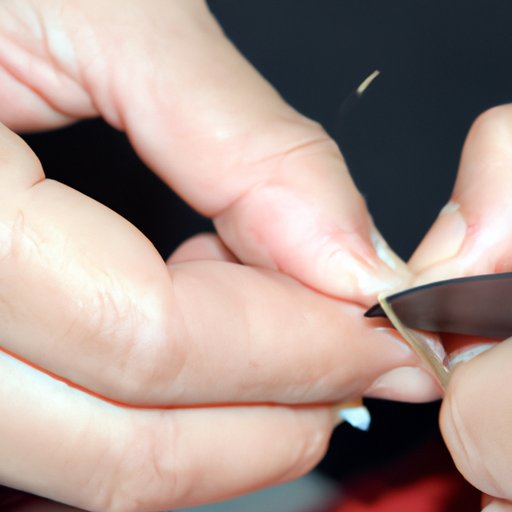
Introduction
Warts are a common skin condition caused by the human papillomavirus (HPV). While they can be harmless, they can also be unsightly and uncomfortable. Warts typically go away on their own over time, but some people choose to remove them for aesthetic reasons. The most common removal methods include freezing, burning, and excision by a medical professional. However, some people wonder if they can cut off a wart at home. In this article, we’ll explore the risks and benefits of at-home wart removal and provide a step-by-step guide to safely removing a wart with an over-the-counter kit.
Risks and Benefits of Cutting off a Wart at Home
While cutting off a wart at home may seem like a cost-effective and convenient option, it can come with some serious risks. Firstly, attempting to remove a wart on your own can increase your risk of infection, bleeding, and permanent scarring. When a wart is cut off, it creates an open wound that is susceptible to bacterial infection, leading to inflammation and delayed healing. What’s more, cutting off a wart on your own increases the risk of a permanent scar, which may be worse than the original wart.
There are some potential benefits to at-home wart removal; however, they are far outweighed by the potential risks. At-home removal kits are typically cheaper than professional treatment, and you can use them in the comfort of your own home. But even with the benefits, it’s important to consider the risks and weigh them against the cost savings.
If you are considering attempting to remove a wart at home, it’s important to ensure that you are a good candidate for at-home removal. If the wart is located in a sensitive area, is bleeding, or is changing in size or color, it is best to seek professional medical treatment to avoid further complications.
Comparing Wart Removal Methods
There are a variety of options for wart removal, ranging from over-the-counter products to professional treatments. Over-the-counter products, such as salicylic acid and freezing sprays, can be effective for treating small warts. However, they may not be effective for larger or more difficult-to-treat warts. Professional treatments, such as cryotherapy (freezing the wart), electrosurgery (burning the wart), or excision (cutting the wart off), are typically more effective for larger or stubborn warts, but they also come with more risks and are more expensive than at-home remedies.
If you decide to try at-home removal, it’s important to follow the instructions carefully and choose a treatment that is safe for your skin type and the area where the wart is located. It’s also important to use sterile equipment and to avoid touching the wart with your bare hands.
Interview with a Dermatologist
We spoke with Dr. Emily Williams, a board-certified dermatologist, to get her professional opinion on at-home wart removal. “Cutting off a wart at home is not safe and can lead to complications such as bleeding, infection, and permanent scarring,” she warns. “If you have a wart that is bothersome, it’s important to seek professional medical treatment.” Dr. Williams also recommends using an over-the-counter removal kit that contains salicylic acid, which is safe and effective for most people. However, it’s important to follow the instructions carefully and avoid using any product that causes pain or irritation.
Real-Life Stories
We spoke with several people who attempted to cut off a wart at home to hear about their experiences. While some people were successful in removing the wart, many experienced complications such as bleeding or infection. “I tried to cut off a wart on my finger using nail clippers, and it bled profusely,” says Sarah, 28. “I had to go to the emergency room to get it properly treated.”
Based on these real-life stories, it’s clear that at-home wart removal can be dangerous and lead to serious complications. It’s important to carefully consider the risks before attempting to do it on your own.
Step-by-Step Instructions for Safe Removal with an Over-the-Counter Kit
If you have decided to try an at-home removal kit, it’s important to follow these safe removal instructions:
- Clean the area around the wart with soap and water, and dry completely.
- Protect the surrounding skin with petroleum jelly or a bandage.
- Apply the removal solution according to the instructions.
- Cover the area with a bandage or tape.
- Repeat these steps daily until the wart is gone.
It’s important to avoid touching the wart with your bare hands and to avoid picking at it. If you experience any pain or discomfort, stop using the product immediately and seek professional medical treatment.
Debunking Myths and Misconceptions
There are many myths and misconceptions surrounding wart removal, with the most common being that cutting off a wart is a safe and effective removal method. However, this is far from the truth. Cutting off a wart at home can lead to serious complications, including infection, bleeding, and permanent scarring. It’s important to seek professional medical treatment for warts that are bothersome or located in sensitive areas.
Conclusion
In conclusion, cutting off a wart at home is not a safe or effective removal method. While it may be tempting to attempt to remove the wart on your own, it’s important to consider the potential risks and seek professional medical treatment if necessary. If you decide to try an over-the-counter removal kit, it’s important to follow the instructions carefully and avoid any product that causes pain or irritation. Accurately diagnose your warts or skin tags before using any medium of treatment may it be over the counter or prescribed treatment.




